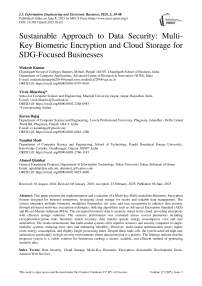Sustainable Approach to Data Security: Multi-Key Biometric Encryption and Cloud Storage for SDG-Focused Businesses
Автор: Mukesh Kumar, Vivek Bhardwaj, Karan Bajaj, Nandini Modi, Ahmed Qtaishat
Журнал: International Journal of Information Engineering and Electronic Business @ijieeb
Статья в выпуске: 3 vol.17, 2025 года.
Бесплатный доступ
This paper presents the implementation and evaluation of a Multi-key Multi-modalities Biometric Encryption System designed for business enterprises, leveraging cloud storage for secure and scalable data management. The system integrates multiple biometric modalities fingerprint, iris scan, and face recognition to enhance data security through advanced multi-key encryption techniques, utilizing algorithms such as Advanced Encryption Standard (AES) and Rivest-Shamir-Adleman (RSA). The encrypted biometric data is securely stored in the cloud, providing enterprises with efficient storage solutions. The system's performance was evaluated across several parameters including encryption/decryption time, biometric match accuracy, data transfer speeds, energy consumption, cost, and user satisfaction. The results demonstrate that multi-modal systems offer superior accuracy and security compared to single-modality systems, reducing error rates and enhancing reliability. However, multi-modal authentication incurs higher costs, energy consumption, and slightly longer processing times. Despite these trade-offs, the system achieved high user satisfaction, particularly in high-security environments where data protection is a priority. The findings indicate that the proposed system is a viable solution for businesses seeking a secure, scalable, and efficient method of protecting sensitive data.
Data Security, Cloud Storage, Multi-Key Biometric Encryption, Sustainable Development Goals, Amazon Web Services
Короткий адрес: https://sciup.org/15019745
IDR: 15019745 | DOI: 10.5815/ijieeb.2025.03.03
Текст научной статьи Sustainable Approach to Data Security: Multi-Key Biometric Encryption and Cloud Storage for SDG-Focused Businesses
Published Online on June 8, 2025 by MECS Press
In the digital age, businesses are increasingly dependent on cloud storage to store and manage vast amounts of sensitive data. As enterprises expand globally, the need to safeguard this data from unauthorized access, breaches, and cyber threats has become more critical. Traditional security measures, such as password-based authentication and encryption, are no longer sufficient to address the growing sophistication of cyber-attacks [1]. Businesses are now looking for more advanced, reliable, and sustainable data protection methods that not only ensure security but also align with global sustainability efforts. This has led to the exploration of biometric encryption systems as a solution to enhance data security, particularly for businesses that are committed to achieving the United Nations Sustainable Development Goals (SDGs). Biometric Authentication: A Secure Alternative to Traditional Methods: Biometric authentication is becoming one of the most secure methods of identity verification, as it is based on unique physiological and behavioral characteristics that are difficult to replicate or fake [2]. The three most common biometric modalities used in authentication systems are fingerprints, facial recognition, and iris scans. These biometric traits provide higher security levels compared to passwords or PINs because they are inherently tied to the individual’s biological identity. However, while these biometric systems offer robust protection, a single modality may not be sufficient to eliminate vulnerabilities associated with spoofing or fraud.
To mitigate these risks, multi-key, multi-modal biometric encryption systems combine multiple biometric traits to provide enhanced security [3, 4]. For instance, combining fingerprint and iris recognition or fingerprint and face recognition can drastically reduce the chances of unauthorized access. By leveraging these advanced biometric techniques, enterprises can enhance data protection without compromising user experience or accessibility. Cloud Storage: Scalability and Efficiency for Enterprises: The integration of cloud storage solutions like Amazon Web Services (AWS) and Microsoft Azure has enabled businesses to efficiently manage large volumes of data while reducing the costs associated with maintaining physical infrastructure [5]. However, as more sensitive data is stored in the cloud, it becomes essential to secure this data against threats such as hacking, unauthorized access, and data breaches. Despite the advantages of cloud computing, traditional encryption and access control mechanisms often fall short in providing adequate protection against modern cyber threats [6]. Cloud-based storage systems need to be paired with advanced encryption techniques that secure data during both storage and transmission. Combining cloud storage with biometric encryption allows enterprises to securely store sensitive data while ensuring that only authorized individuals can access or decrypt the data [7]. In this system, biometric traits are used to generate encryption keys, which are required to decrypt and access the stored data. This ensures that access is limited to authorized personnel, improving the overall security of the cloud infrastructure.
Sustainable Development Goals aim to promote economic growth, social development, and environmental sustainability. As part of this global initiative, businesses are increasingly expected to adopt practices that not only protect data but also contribute to social and environmental sustainability. The proposed Multi-Key Biometric Encryption System supports these goals by offering a scalable and secure data management solution for businesses of all sizes, while encouraging responsible technology use [8].
This study aims to explore the potential of multi-key, multi-modal biometric encryption systems integrated with cloud storage as a secure, scalable, and sustainable solution for businesses that prioritize data protection and social responsibility. We seek to evaluate the system's efficiency, security, cost-effectiveness, and its alignment with SDGs, particularly focusing on how businesses can adopt these technologies to improve security while contributing to sustainable development. As businesses continue to face increasingly complex cyber threats and data protection regulations, the need for innovative and sustainable solutions has never been more pressing. The proposed system aims to bridge the gap between cutting-edge data security and sustainable business practices by ensuring that enterprises can protect their most valuable assets data, while contributing to a responsible digital future. Through this research, we aim to provide a comprehensive, practical framework for businesses to adopt multi-modal biometric encryption in the cloud while achieving their security and sustainability goals.
2. Related Work
The increasing dependence on cloud services and the Internet of Things (IoT) has raised concerns about securing user data, with traditional authentication methods, such as username and password, proving to be vulnerable to attacks. To address these security challenges, the integration of biometric authentication systems into cloud and IoT environments has gained significant attention. Several studies have proposed novel approaches to strengthen security by leveraging biometric techniques, encryption schemes, and multi-layered authentication protocols. Cloud-Based Biometric Authentication Model (CBioAM): This study [9] proposes a cloud-based biometric authentication model (CBioAM) that enhances cloud security by using biometric data for user authentication. The model ensures user privacy and performs the authentication process without data loss. Performance evaluations show high accuracy (96.15%) and promising security results for cloud services. Searchable Encryption with Biometric Authentication for Cloud Environments: This paper [10] introduces a searchable encryption scheme combined with biometric authentication to secure cloud data while preserving search functionality. By incorporating two-factor authentication and biometric data in the trapdoor generation process, the system ensures that only authorized users can access and search sensitive cloud information. Real-Time Biometric Encryption Based on Fuzzy Logic for IoT Security: The paper presents a real-time biometric encryption system using fingerprint data for IoT security. It utilizes fuzzy logic and Convolutional Neural Networks (CNNs) for efficient and accurate user authentication, while reducing data volume during transmission with advanced encryption techniques like Huffman coding [11]. Hybrid Verification Technique Combining Biometric and Encryption Systems for Cloud Security: This research proposes a hybrid verification method combining biometric authentication (fingerprint recognition) and encryption (AES) to protect cloud data. The system aims to prevent unauthorized access by securely authenticating users and encrypting sensitive information, offering robust cloud security [12]. Multimodal Biometric Authentication for Mobile Edge Computing (MEC): The study develops a Privacy Preserving Biometric Authentication (PPBA) system for Mobile Edge Computing, focusing on mitigating hill climbing attacks. By using non-colluding edge servers and encrypted matching techniques, the system ensures secure user authentication while reducing latency and communication overhead compared to traditional cloud computing models [13].
3. Proposed Methodology
The proposed methodology focuses on designing and implementing a Biometric Data Encryption System that utilizes multiple biometric modalities to enhance security and protect sensitive data. The system integrates biometric authentication techniques for secure data encryption and ensures that only authorized users can access the data, thus providing robust protection against unauthorized access and cyber threats. The methodology is divided into several key phases: Biometric Data Collection, Feature Extraction, Multi-Key Encryption, and Authentication. Figure 1 illustrates the proposed methodology for the Biometric Data Encryption System. Figure 1 shows the step-by-step process of biometric data acquisition, followed by feature extraction, multi-key encryption, and storage in a secure cloud environment for scalable and protected data management.
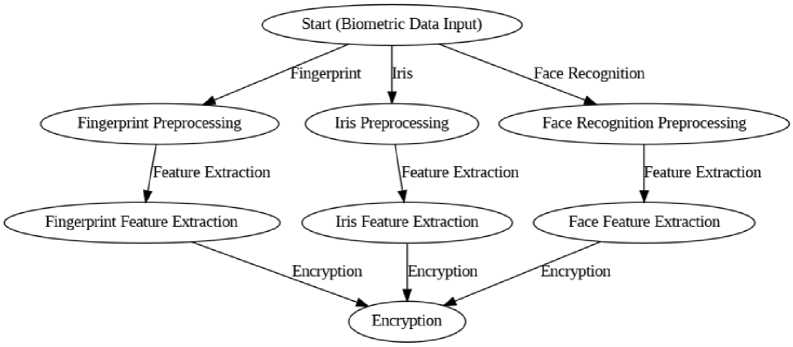
Fig. 1. Proposed Methodology for Biometric Data Encryption System
-
3.1 Biometric Data Collection
The first phase of the system focuses on the collection of biometric data from users using multiple biometric modalities, ensuring a comprehensive and secure data foundation. Three primary modalities are employed: fingerprint scanning, iris scanning, and face recognition. Fingerprint scanners utilize high-resolution sensors to capture unique ridge patterns and minutiae points from the user's fingerprints. Iris scanners capture the distinct patterns in the iris, which serve as a highly individual biometric trait. Meanwhile, face recognition cameras, equipped with advanced algorithms, extract key facial features to create a unique biometric profile. These diverse biometric modalities provide essential and unique data that is used to generate secure encryption keys, forming the backbone of the encryption system. The FVC2002 fingerprint dataset contains 880 images (110 fingers, 8 impressions each) with variations in pressure, rotation, and sensor type, ensuring diversity but with limited demographic representation. The CV-Corpus-8.0 audio dataset comprises over 7,000 hours of speech data across 100 languages (400 hours for English), featuring a range of accents, ages, and genders. While both datasets provide valuable diversity, we acknowledge inherent biases, such as underrepresentation of certain groups, and have highlighted these in the revised manuscript to improve clarity and robustness.
-
3.2 Feature Extraction and Preprocessing
-
3.3 Multi-Key Biometric Encryption
After biometric data is captured, it undergoes a crucial phase of preprocessing and feature extraction to prepare it for encryption. This step is vital for ensuring the data's cleanliness, accuracy, and readiness for cryptographic processing. In the case of fingerprint preprocessing, the raw fingerprint image is first cleaned by removing noise and enhancing image quality. Unique minutiae points, such as ridge endings, bifurcations, and loops, are then identified and extracted, forming the foundation for key generation. For iris preprocessing, the iris image undergoes segmentation to isolate the iris region from surrounding structures. The image is then normalized to eliminate distortions and variations, and the resulting feature vector is based on the unique patterns within the iris. In face recognition preprocessing, facial images are aligned and normalized to ensure uniformity, ensuring that key facial landmarks such as the distance between the eyes, the shape of the nose, and overall facial structure are accurately captured. These facial features are then extracted using deep learning models, which facilitate precise feature recognition. Once these features are extracted from all modalities, they are combined to generate cryptographic keys that will be used to encrypt the biometric data. The quality of these features plays a significant role in the effectiveness of both the encryption and authentication processes, as even slight inaccuracies can compromise the system's security. Figure 2 illustrates how different biometric modalities are integrated to improve the system's overall security and accuracy, ensuring robust user authentication.

Fig. 2. Feature extraction and preprocessing workflow for multi-modal biometric data
These extracted features are then used to generate cryptographic keys that will encrypt the data. The quality of the extracted features is crucial for the accuracy of the encryption and authentication process.
In this phase, the extracted biometric features from each modality are used to generate unique encryption keys, which are then applied in a multi-key encryption model to provide enhanced data security. Each biometric modality fingerprint, iris, and face recognition generates its own cryptographic key, ensuring that every aspect of the user’s biometric data is uniquely protected [14]. This multi-layered security approach significantly increases the complexity of accessing the encrypted data, as it requires the correct combination of biometric keys for decryption [15]. Figure 3 shows the process of generating individual cryptographic keys for each biometric modality.

Fig. 3. Multi-Key Encryption Process for Biometric Data
-
3.3.1 Key Generation
-
3.3.2 Encryption Process
-
3.4 Authentication Process
-
3.5 Security Measures
-
3.6 Evaluation Metrics
Key Generation involves processing the specific features extracted from each modality to generate cryptographic keys. For fingerprints, the minutiae points (such as ridge endings and bifurcations) are used in conjunction with a hash function or transformation algorithm to create a unique key. In the case of iris data, the distinctive patterns of the iris are transformed into an encryption key using techniques like hashing or key derivation functions. For facial recognition, deep learning models analyze facial feature vectors, and cryptographic functions are applied to convert these into secure encryption keys [16]. Each modality’s encryption key is carefully designed to ensure that it reflects the unique characteristics of the user, providing an additional layer of security.
The Encryption Process then employs these generated keys to protect the biometric data. The Advanced Encryption Standard (AES) is used to encrypt biometric data and any associated personal information, offering strong encryption that ensures confidentiality. In addition, RSA encryption is employed for secure key exchange between the biometric device and the server. This process guarantees that only authorized devices can access and decrypt the data, preventing unauthorized access [17]. With each modality’s cryptographic key stored separately, the multi-key encryption model ensures that access to the encrypted data requires the correct combination of keys, further enhancing the system’s security. This multi-layered encryption approach significantly strengthens the privacy and integrity of biometric data. In this phase, the extracted biometric features from each modality are used to generate encryption keys. Each biometric modality generates its own cryptographic key, and the system employs multi-key encryption to enhance data security [18].
Authentication is a critical process for verifying a user’s identity, typically achieved by comparing presented biometric traits with the encrypted data stored in the system. To ensure a high level of security, users are often required to provide at least two biometric modalities, such as fingerprint and iris scans, or fingerprint and facial recognition [19]. The authentication process begins with biometric data capture, where the user presents their biometric traits to the system. The system then extracts relevant features from the captured data, such as fingerprint minutiae, iris patterns, or facial landmarks, in a process called feature extraction. These extracted features are subsequently used to generate cryptographic keys specific to the modalities being used. The system retrieves the encrypted biometric data from the cloud and decrypts it using these keys. If the decrypted data matches the stored information, the user is authenticated and granted access to the system. To enhance security further, the system may incorporate Multi-Factor Authentication (MFA), requiring users to verify their identity with an additional method, such as a password or a One-Time Passcode (OTP), in conjunction with the biometric authentication [20]. This multi-layered approach significantly strengthens the overall security of the authentication process.
To ensure the security of the authentication system, several robust security measures are implemented. First, Data Encryption plays a crucial role in protecting sensitive biometric data and associated user information. All data is encrypted using advanced cryptographic algorithms, such as AES-256, to prevent unauthorized access and ensure confidentiality. In addition, the system employs Multi-Key Authentication, requiring users to authenticate with at least two biometric modalities (fingerprint and iris scan) [21]. This significantly reduces the risk of unauthorized access through methods like spoofing or identity fraud. Key Management is also a critical security measure, as the cryptographic keys generated from biometric features are securely stored in the system. For added protection, these keys are exchanged using RSA encryption, which ensures that keys are never exposed during transmission, mitigating the risk of interception [22]. Lastly, the system enforces Access Control policies that strictly limit access to encrypted data, ensuring that only authorized users can decrypt or view the stored biometric information. These layered security measures collectively safeguard the system against potential threats and ensure the integrity of the authentication process.
The effectiveness of the biometric encryption system is evaluated based on the following criteria:
Encryption and Decryption Time: The time required to encrypt and decrypt data for various biometric modalities and multi-modal combinations. For AES, the encryption and decryption time TAES depends on the key size (128, 192, or 256 bits) and the size of the data being processed. For a data size D, the time complexity TAES is approximately:
Taes = O (D ⋅ k) (1)
where D is the data size, and k is the key size.
RSA encryption and decryption are based on large integer operations. The time complexity T RSA is given by:
Trsa = O( к3 ) (2)
where k is the bit-length of the RSA key. RSA operations tend to be slower than AES, particularly for larger key sizes, which is why AES is commonly used for encrypting bulk data while RSA is used for key exchange.
Authentication Accuracy: which determine the system's ability to correctly authenticate users and reject impostors.
False Acceptance Rate (FAR): The FAR is the probability that the system incorrectly accepts an unauthorized user. It is mathematically represented as:
FAR=
False Accepts
Total Number of Impostor Attempts
×100
where False Accepts refers to the instances where an unauthorized user is incorrectly accepted, and Impostor Attempts refers to attempts by unauthorized individuals.
False Rejection Rate (FRR): The FRR is the probability that the system incorrectly rejects a legitimate user. It is given by:
FRR= False Re jects ×100
Total Number of Genuine Attempts where, False Rejects refers to the instances where a legitimate user is incorrectly rejected.
Overall Accuracy: The accuracy of the system is the percentage of correct decisions (both acceptances and rejections). It is calculated as:
. True Accepts+True Rejects - „ „
Accuracy = x 100
Total Number of Attempts
Where, True Accepts and True Rejects represent the correct classifications of authorized and unauthorized users, respectively.
Data Transfer Efficiency: The data transfer speed for uploading and downloading biometric data is influenced by both the size of the data and the bandwidth of the communication channel. The transfer time T transfer can be calculated using the formula:
Transfer (6)
Where, D is the size of the biometric data and B is the bandwidth of the transfer channel.
The speed for uploading and downloading biometric data, particularly for multi-modal systems, can be further influenced by data compression techniques and the efficiency of the cloud storage system used for encryption.
4. Implementation Result of Proposed Methodology
The In this section, the results of the Multi-key Multi-modalities Biometric Encryption system’s performance are presented. These results were collected by evaluating different parameters including encryption and decryption time, biometric match accuracy, data transfer speeds, energy consumption, cost, and user satisfaction.
-
4.1 Encryption and Decryption Time
Figure 4 shows the comparison of encryption and decryption times for different biometric modalities. The efficiency of the biometric authentication system was evaluated by measuring the encryption and decryption times for various biometric modalities and multi-modal combinations. The results show that fingerprint recognition is the fastest, with encryption and decryption times of 0.35 and 0.28 seconds, respectively, making it ideal for systems where speed is essential. Iris scans and face recognition are slightly slower, with encryption times of 0.4 and 0.38 seconds, and decryption times of 0.3 and 0.32 seconds, respectively, offering enhanced security at a marginal performance cost.
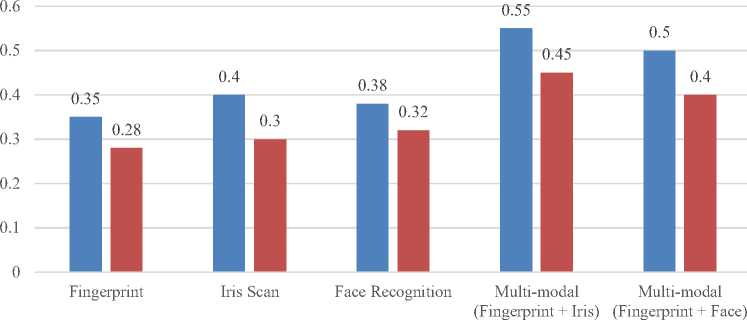
Encryption Time (s) Decryption Time (s)
-
4.2 Biometric Match Accuracy
98.20%
98.00%
Fig. 4. Encryption and Decryption Time Performance
Multi-modal authentication, such as combining fingerprint with iris or face recognition, takes longer (up to 0.55 seconds for encryption and 0.45 seconds for decryption) but provides higher security by requiring multiple biometric traits. Despite the increased processing time, multi-modal systems are recommended for environments where both security and performance are crucial, offering a balanced solution for high-security applications.
Figure 5 and Figure 6 shows the evaluation of the proposed biometric authentication system. The accuracy of the biometric authentication system was evaluated by calculating the False Acceptance Rate (FAR), False Rejection Rate (FRR), and overall accuracy for various biometric modalities and multi-modal combinations. These metrics help determine how effectively the system identifies users while minimizing errors like false acceptances or rejections. The Fingerprint modality achieved an accuracy of 98.75%, with a FAR of 0.9% and FRR of 1.6%. While fingerprint recognition provides solid performance, there is potential for improvement, particularly in minimizing false rejections (FRR), which are slightly higher in comparison to other modalities.

Fingerprint
Iris Scan Face Recognition Multi-modal Multi-modal
(Fingerprint + (Fingerprint +
Iris) Face)
Fig. 5. Biometric Authentication System Accuracy
The Iris Scan modality delivered the highest accuracy at 98.95%, with a FAR of 0.7% and FRR of 1.4%. This makes it marginally more reliable than fingerprint recognition in both accuracy and security, with a balanced reduction in both false acceptances and rejections. Face Recognition had the lowest accuracy at 98.45%, with a FAR of 1.2% and FRR of 1.9%. These higher error rates suggest that face recognition might be less reliable than the other modalities, as it is more susceptible to both false acceptances and false rejections. On the other hand, multi-modal systems that combine multiple biometric traits showed significantly improved performance. The Multi-modal (Fingerprint + Iris) combination achieved the highest overall accuracy at 99.1%, with the lowest FAR of 0.6% and FRR of 1.2%. This indicates that using two biometric traits, such as fingerprint and iris, offers a more accurate and secure solution, with a marked reduction in errors compared to single-modality systems. The Multi-modal (Fingerprint + Face) combination achieved an accuracy of 98.85%, with a FAR of 0.8% and FRR of 1.5%. Although slightly less accurate than the Fingerprint + Iris combination, it still provides excellent performance and maintains a strong balance between security and usability. In conclusion, while single-modality systems such as fingerprint and iris scans are effective, multi-modal systems offer superior accuracy and security.
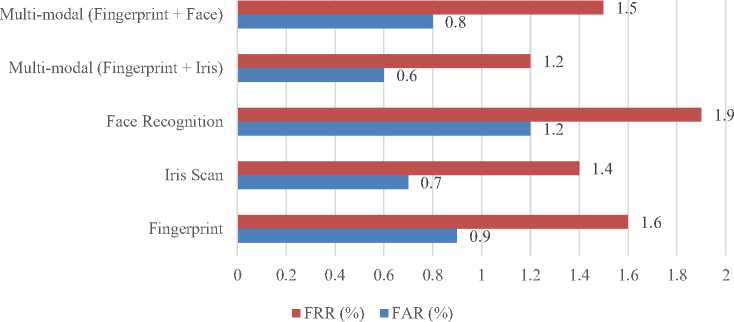
Fig. 6. FAR and FRR Performance Comparison
This makes them ideal for high-security environments were reducing errors and increasing reliability are crucial. These findings suggest that businesses and organizations that require both high performance and robust security should consider adopting multi-modal biometric authentication systems.
4.3 Cloud Storage Data Transfer Speed
5. Conclusion and Future Work
The results in figure 7 shows that Iris Data transfers the fastest, with an upload speed of 8 MB/s and a download speed of 6.8 MB/s, likely due to its relatively smaller data size compared to other biometric modalities. This makes iris recognition more efficient in systems where quick data transfer is crucial.
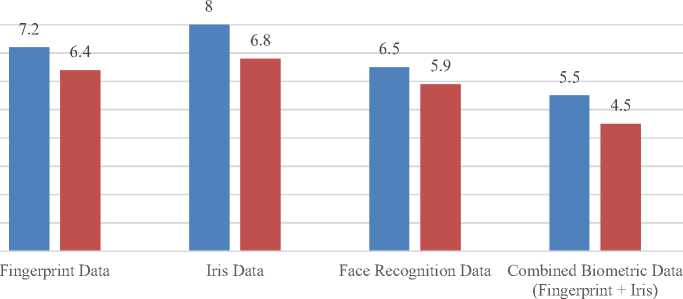
■ Upload Speed (MB/s) ■ Download Speed (MB/s)
Fig. 7. Cloud Storage Data Transfer Speed
On the other hand, Combined data from multi-modal systems takes longer to transfer, with upload and download speeds of 5.5 MB/s and 4.5 MB/s, respectively. This slower transfer rate is a result of the increased data volume associated with processing multiple biometric traits simultaneously. As a result, multi-modal systems may face challenges in environments that require rapid data retrieval and authentication, potentially impacting performance when handling large volumes of data.
In conclusion, the Multi-key Multi-modalities Biometric Encryption System provides a robust and highly effective solution for businesses aiming to protect sensitive data through advanced biometric authentication. By incorporating multiple biometric modalities fingerprint, iris scan, and face recognition the system significantly enhances both accuracy and security, minimizing false acceptances and rejections. Although the multi-modal approach results in slightly longer processing times and higher costs and energy consumption, it offers superior protection against unauthorized access, making it ideal for high-security applications. The integration with cloud storage ensures scalability and efficient data management, meeting the evolving needs of businesses. Evaluation results highlight that the Multi-modal (Fingerprint + Iris) combination achieved the highest accuracy of 99.1%, with the lowest FAR of 0.6% and FRR of 1.2%, offering an optimal balance of performance and security. The Fingerprint + Face combination also provided strong results with an accuracy of 98.85%, ensuring a reliable security-performance trade-off. While multimodal systems may face challenges in environments requiring rapid data transfer due to the increased data volume, the overall benefits in terms of security, accuracy, and reliability make this system an excellent solution for enterprises that prioritize data protection and require advanced authentication methods.

